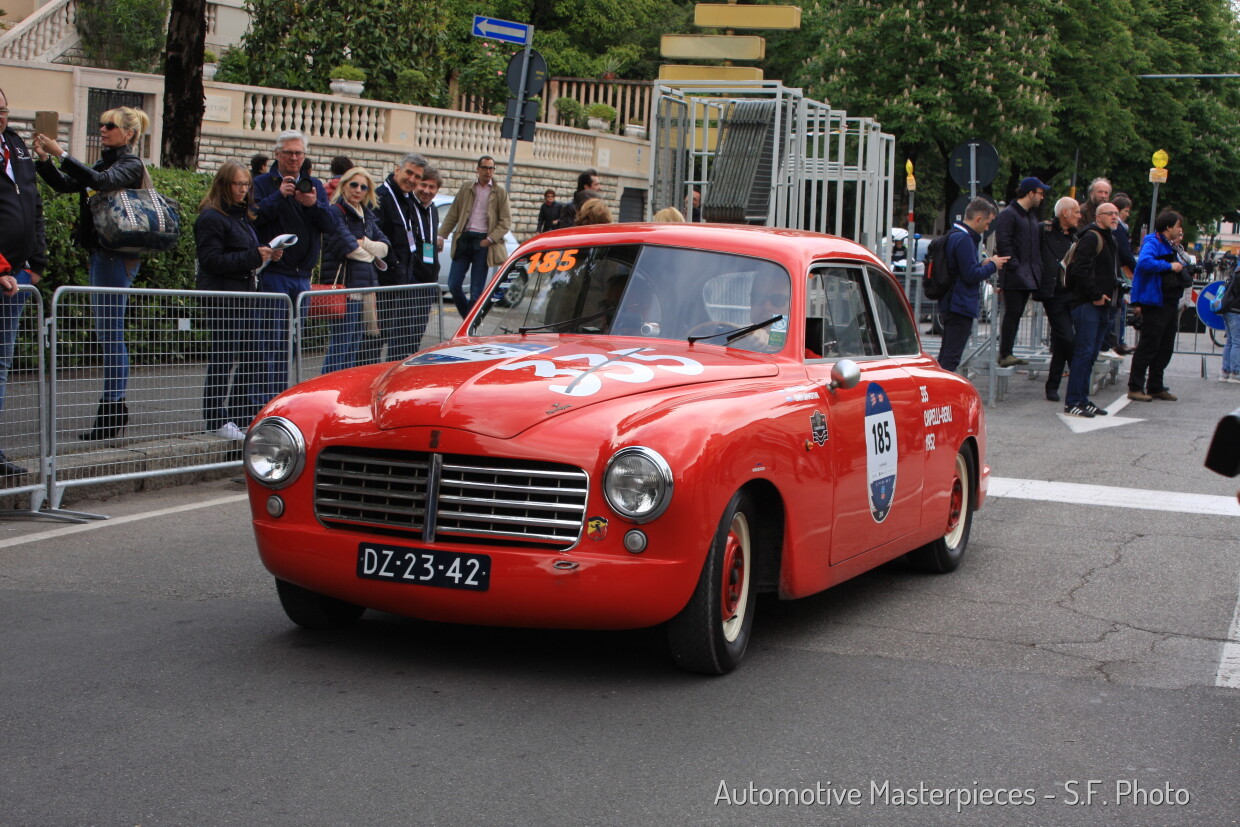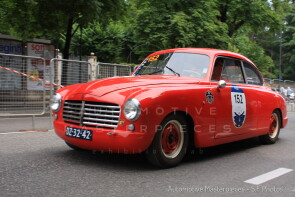
1950 Fiat 1400 Berlinetta Abarth
ON/OFF
Why am I an Automotive Masterpiece?
Work of Dante Giacosa, who was able to synthesize different needs, the Fiat 1400 was built with a unibody and it was large for a mid-sized car of the time.The American-inspired lines took on a wholely European dimension. The comfort and the reliability made it an excellent car to face the endurance races, especially when it was subjected to the care of the magicians of the time. It was manufactured by Fiat between 1950 and 1958. Introduced in 1950 Geneva Motor Show, it was Fiat’s first post war model and was offered with a monocoque body. Fiat 1400, with petrol engine, was powered by a 1,395 cc inline four cylinder. This engine breathed through two overhead valves per cylinder and produced 50 hp at 4.600 rpm. It was able to generate a torque of 85 N-m at 3.400 rpm. Though the torque curve was not flat, it could still generate 75 N-m at around 1.550 rpm. The power was transferred to the rear wheels through a 4-speed manual gear box. The 1400’s engine could push the 1.490 Kg car to a maximum speed of 125 km/h. Fiat had endowed the car with sufficiently large proportions as per European standards. This car was 4,305 mm long, 1,655 mm wide and 1,550 mm tall.
At the 1950 Salone Internazionale dell’Automobile di Torino, the Carrozzeria Touring presented a Superleggera sedan prototype built on the then very modern platform of the Fiat 1400, the new medium-sized load-bearing body car from Fiat. This is the first attempt to adapt the Superleggera structure to a real monocoque. In the factory in Via Ludovico da Breme, the Fiat 1400s are transformed into a two-door four-seater berlinetta in the style of the coachbuilder, with a large grille and a tail similar to that of the 6C 2500 SS Villa d'Este. The car, which was slender and refined compared to the massive production sedan, aroused the attention of a group of Fiat dealers who, led by Ovidio Capelli (at the time one of the most active among them and well known for being a good racing driver, very faithful to the brand) join forces to sign a fairly substantial order, which materialized in a final balance of 200 units. Of these, however, it is not known how many were actually made; it is assumed that there have been very few. The changes that characterized the definitive series include a new simplified front treatment that is more in keeping with the identity of the production car and the addition of the quarter window. The original front of the prototype had proposed an interesting and cultured reinterpretation of the traditional Fiat grille of the 1940s, but its execution was too complex and expensive for the price level in which the vehicle had to fall. Again at the "instigation" of Ovidio Capelli, the final version of the 1400 Superleggera was joined by a group of three special "sport" specimens, further streamlined and lightened, to be used for sporting activities, with the greater inclination of the windshield and the smaller front section in which it stood out the lowered roof. The first racing model was set up in a record time of just 20 days. The passenger compartment was extremely light and equipped with anatomic seats. The total weight of the car was only 842 kg compared to 1130 kg for the production sedan. The mechanical preparation of the three berlinettas was handled by the Centro Studi Fiat, with the use of Abarth components, as shown by the badge applied between the headlight and grille. According to what Carlo Felice Bianchi Anderloni recalled, in addition to the specimen brought into the race personally by Ovidio Capelli, with whom he also won the XI Giro di Sicilia, the second and third specimens would have been purchased by Gianni Agnelli and Leopoldo Pirelli, both for years loyal Touring customers.
The Fiat 1400 Berlinetta Abarth with chassis no.101*004330* was set up by Carrozzeria Touring and completed on 31 July 1950. The car, rediscovered and restored in the 1980s by the well-known driver and collector Patrizio Cantù, presents the "standard" body of the berlinetta (with the "high" roof) and the racing set-up of the "sports" version (but without the lowered roof). So the interiors are lightened, the bumpers are missing, the door glasses are of the sliding type, the various friezes are absent. The engine is equipped with the Abarth upgrade kit, announced by the badge on the front. The car's sporting past is still being researched. The car has a long and fruitful career in classic car racing, primarily the Mille Miglia. He completed the first Mille Miglia re-enactment in 1987; the latest, at the moment, in 2019. Chassis no.101*004330* is the only Fiat 1400 Berlinetta Abarth known to exist today.





